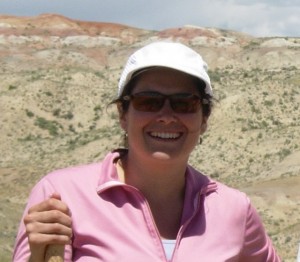
When most of us look at a mountain, we see a monolith that seems unchanging. Geologist Francesca McInerney of Northwestern University sees how a landscape has evolved over millions of years, with features growing and changing, “Like a flipbook through time of ecosystems and organisms changing.” She credits an undergraduate course in Paleobiology at Yale University with introducing her to the long view of the earth’s features. “The thing that interested me at first was large scale temporal and spatial patterns in nature. I always really enjoyed landscapes and how they were created,” she says.
Francesca earned a Bachelor’s degree in Geology and Studies in the Environment from Yale University, and a Master’s degree in Geophysical Sciences from the University of Chicago. She earned her PhD in 2002 from the University of Chicago. Francesca is currently an Assistant Professor of in the Department of Earth and Planetary Sciences at Northwestern University.
Francesca’s research investigates the response of plants to changes in climate in the geologic past. Describing how plants responded to past episodes of climate change may inform scientists about how ecosystems may fare in response to current climate change. She also studies how current plants acquire and turn over basic elements such as hydrogen and carbon, so as to better understand how these features are related to climate features such as humidity.
Over the history of the earth, there have been many cycles of climate change, and Francesca studies one particular event, the Paleocene-Eocene Thermal Maximum (PETM), which occurred about 55 million years ago. Global temperatures increased by 5-8 degrees Celsius due to increased carbon in the ocean and atmosphere. “It happened rapidly on a geologic time scale, taking under ten thousand years. We know that from carbon isotopes and deep ocean acidification. It caused major changes in where organisms lived, so there were huge migrations,” she explains. While a concern of modern climate change is the effect it may have on many species, during the PETM, “Not that many groups experienced extinction,” she says. However, one of the main differences is that while the Paleocene-Eocene event took thousands of years, the current change is being accomplished in centuries.
How do scientists determine the environment that a particular plant lived in 55 million years ago? When a plant is alive, it produces wax that covers its leaves and retains moisture. Even after millions of years, when other biological material have been destroyed, some lipids in leaf waxes are still present in the rocks as molecular fossils. And those waxes can tell you about the climate that the plant lived in. In particular, she looks at a component of leaf waxes, straight chain alkanes, one type of which is produced almost exclusively by vascular plants.
Francesca studies vascular plants that lived in the Big Horn basin in Wyoming during the PETM. “Wyoming used to be quite lush and green, 56 million years ago.” To study carbon cycling in terrestrial ecosystems, the rocks must be cleaned and ground up, and the lipids extracted using solvents, heat and pressure. The carbon and hydrogen isotopes in the lipids are analyzed using mass spectrometry. “An isotopically distinct pool of carbon was added to the oceans and atmosphere, and that signal is seen in the oceans and in tooth enamel (of animals), soils, and plants.” On land, there was a larger shift than in the ocean. Francesca explains that, “We are trying to understand what the real global shift was, and why it was different between the terrestrial and marine.” Comparing the isotope profile of the hydrogen in the plants, versus that in the tooth enamel of grazing animals, who also drink surface water, describes how precipitation and humidity may have changed.
She also studies the relationship between the environment and the cycling of carbon and hydrogen isotopes in modern plants in collaboration with the Chicago Botanic Garden. Studying current plants helps to calibrate standards for paleontological samples.
In her laboratory, she has two PhD students, one Masters student and “a slew of undergrads.” She describes herself as an informal but involved mentor, characterized by a lot of contact, both at Northwestern and in the field. “I meet frequently with the lab group as a whole and with each student individually.“ She also promotes the students mentoring each other, with the graduate students mentoring the undergraduates.
Her teaching duties include undergraduate courses on Paleobiology, which deals with the history of life through geologic time, and introduces the methods to study the evolution of ecosystems. She also teaches a freshman seminar titled “Global Warming: The Scientific Evidence.” She says, “I like them both because they’re both fairly inter-disciplinary in what you talk about.” She also teaches graduate seminars in stable isotope ecology and paleoecology.
Describing her work, Francesca says she’d always been interested in environmental issues and conservation, but that had not been a direct driver of her research until recently. She says, “It’s come full-circle. I was initially interested in very local environmental issues, and found my interest in geology was something separate. Now it’s come around to where I feel that studying past climate change is extremely relevant to global environmental issues, but I didn’t see that connection when I started – it wasn’t so clear then.”
Nomination and article submitted by AWIS Chicago VP for Communications Michelle Merrigan.
*Know a scientist you think should be featured in an upcoming “Scientist of the Month” article? Send nominations to Michelle Merrigan and Carrie Heusner. Your nominee does not need to be an AWIS member or a woman, but should promote the advancement of women in science, technology, mathematics and engineering.
Want to keep yourself up-to-date on AWIS Chicago activities? Follow AWIS Chicago on Twitter! You can request to be added to our listserve by clicking here, and join the AWIS Chicago group on LinkedIn and Facebook by clicking the icons on the bottom right of this page.
